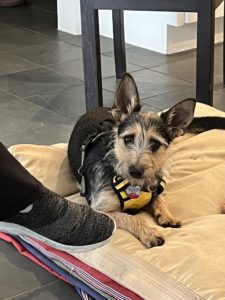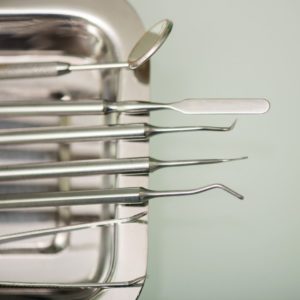Michael Baugh CDBC CPDT-KSA CSAT
One-twenty over seventy-four. I’m lying back in the dentist’s chair with the wrist monitor to my chest when the beep sounds. Honestly, I am a bit surprised when I read the display: 120 / 74. That’s a fairly respectable blood pressure for me on any given day. On dental exam day, it’s an exceptional blood pressure. A few years ago it would have been unimaginable. I broke into sweats during cleanings and exams. My whole body tensed at the sound of a drill. I fainted once while getting a lidocaine injection. Not today, not with 120 / 74. I smile, slip off the monitor and put on the protective glasses. How did I get from terror to today? And, you might be wondering, what the hell does this have to do with dog training?
Everything.
 I’ve helped a lot of people who have dogs who are afraid, afraid of the vet, but also afraid of people in general, afraid of other dogs, of garbage trucks, even dogs who are afraid of leaves in the wind (seriously). My own dog, Stewie, used to be terrified of vet visits, the needle parts especially. Helping dogs work through fear is a process. Notice I didn’t say teaching dogs to … or training dogs not to…. We are helping dogs. And, there are some consistent elements in the process.
I’ve helped a lot of people who have dogs who are afraid, afraid of the vet, but also afraid of people in general, afraid of other dogs, of garbage trucks, even dogs who are afraid of leaves in the wind (seriously). My own dog, Stewie, used to be terrified of vet visits, the needle parts especially. Helping dogs work through fear is a process. Notice I didn’t say teaching dogs to … or training dogs not to…. We are helping dogs. And, there are some consistent elements in the process.
- Set your dog up to succeed. This means creating an environment in which your dog can at least experiment with relaxing. Create a space where safety is possible.
- Teach a routine. This is optional in many cases. But, I’ve found it’s smart to give the dog a few tasks he can reliably perform for reinforcement. Dogs are great at learning patterns. (This is why I often teach a relaxed down or the look-at-that game).
- Pay attention to what your dog is telling you about his feelings. If the scene is getting too stressful for him, give him an out. Take a break. Let him catch is breath and settle himself again. When meeting a frightened dog I’ll often ask the human to put the dog in a quiet room away from me several times throughout the visit. He may get as many as a half dozen repetitions of coming out to see me. Each time it gets easier. Taking breaks works.
- Similarly, let your dog make some reasonable choices. He can tell you when he’s ready to try a more challenging experience. I’m always so pleased when a dog comes out on try number 5 or 6 and casually walks up to me. That was his choice. Part of the routine I taught Stewie for vet visits was resting his head in the palm of my hand (Yes, it is adorable). That tells me he’s ready for his jugular blood draw (no chin rest – no blood draw – not until he’s ready). Letting you dog make some of these simple choices on his own really does speed up your progress.
- Don’t let anyone shame you. Ignore well-meaning friends who tell you your dog needs more exposure or that you need to force a situation so he just gets over the fear. Rebuke the myth that giving your dog comfort somehow reinforces fear. This is bunk. And if an animal professional tells you any of this nonsense, gently call them out. At best they are giving you misinformation. At worst, it’s malpractice.
 Six years ago I switched dentists. I set myself up to succeed and found a dental practice that truly understood fearful patients like me. (Healthy Smiles Family Dentistry in Houston). Together we established a routine. At this practice, when you arrive on time you are invited back to the exam area on time. There’s no sitting and stewing over what’s about to happen. I set down my phone and glasses. The hygienists and I chat. She never leaves the room (no more waiting alone at all). Then Dr. Vlachakis (Dr. V) and I chat. From the beginning the staff and Dr. V paid attention to what I was saying and feeling. It turns out they consider their patients’ physical and emotional comfort part of their job (Well, that’s refreshing). I remember my first visit when I tried to calmly let them know how scared I was. Meanwhile I was already sweating and my eyes were darting around the room like a scared dog. And, I hadn’t even sat down in the chair yet. “You’ll be okay.” They told me. “Have a seat whenever you’re ready.” I got to make my own reasonable choices. Sit down in the chair when you are ready. It’s a small thing, but a very big deal. They offered me nitrous oxide. I accepted (The truth is we needed to bring my blood pressure down). All I was having done was a cleaning, but I took the laughing gas. And, there was no shame from anyone.
Six years ago I switched dentists. I set myself up to succeed and found a dental practice that truly understood fearful patients like me. (Healthy Smiles Family Dentistry in Houston). Together we established a routine. At this practice, when you arrive on time you are invited back to the exam area on time. There’s no sitting and stewing over what’s about to happen. I set down my phone and glasses. The hygienists and I chat. She never leaves the room (no more waiting alone at all). Then Dr. Vlachakis (Dr. V) and I chat. From the beginning the staff and Dr. V paid attention to what I was saying and feeling. It turns out they consider their patients’ physical and emotional comfort part of their job (Well, that’s refreshing). I remember my first visit when I tried to calmly let them know how scared I was. Meanwhile I was already sweating and my eyes were darting around the room like a scared dog. And, I hadn’t even sat down in the chair yet. “You’ll be okay.” They told me. “Have a seat whenever you’re ready.” I got to make my own reasonable choices. Sit down in the chair when you are ready. It’s a small thing, but a very big deal. They offered me nitrous oxide. I accepted (The truth is we needed to bring my blood pressure down). All I was having done was a cleaning, but I took the laughing gas. And, there was no shame from anyone.
It’s been like this from the first visit, and consistently every visit thereafter. I come in. We go back on time. I’m never alone. I set my phone and glasses down. I sit in the chair and strap on the blood pressure monitor, slip on the protective glasses. The hygienist and I chat. Dr. V and I chat. (She comes in even before the cleanings). And then she asks me, “are you ready.” I usually take a deep breath, even now. “Sure, ready.” Ready for cleanings. Ready for the occasional filling. Ready for an implant. Ready for veneers (Yup, I opted in for cosmetic dentistry). Ready with nitrous oxide for the early visits but rarely anymore. Ready for the chats and always for the kindness, and the sunny view from the chair, and the time to relax. Yes, relax (most of the time).
The blood pressure cuff is on the counter. The hygienist must have forgotten to put in in the drawer. 120 / 74. Wow. We are half way through the cleaning. She pauses to let the suction thing in my mouth do its thing. “You okay?” She asks. “Need a break?”
“Thank you,” I answer. “I’m good.” I take a breath. I’m good.
Michael Baugh teaches dog behavior in Houston Tx. He specializes in fearful and aggressive dog training. Michael also has no cavities as of his most recent visit to the dentist.
